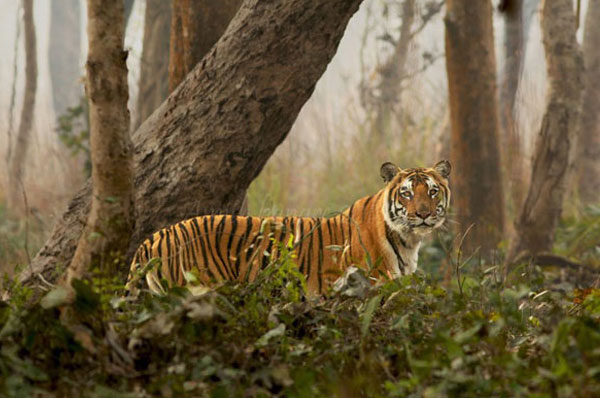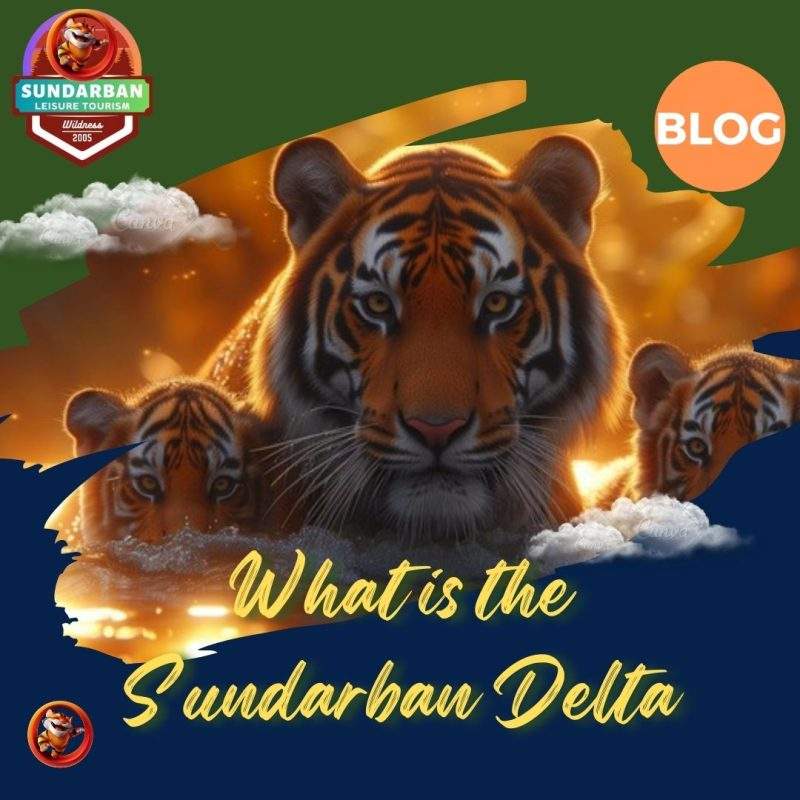Where Are the Sundarbans Located: The Sundarbans, an enigmatic and enchanting region, is one of the world’s most unique ecosystems. Nestled in the delta formed by the confluence of the Ganges, Brahmaputra, and Meghna rivers, the Sundarbans is a labyrinth of tidal waterways, mudflats, and small islands, with lush mangrove forests. This article delves into the geographical location, ecological significance, and captivating experience offered by Sundarban Leisure Tourism, ensuring you have all the details to plan an unforgettable visit to this natural wonder. For further information, check out the section on “Where Are the Sundarbans Located” in this blog.
Read More:
| “Sundarban by Boat: Navigating the Mangrove Maze” |
| “Birdwatching in the Sundarbans: A Birder’s Delight” |
| “Tiger Spotting in the Sundarbans: Tips and Tricks” |
Geographical Location
The Sundarbans spans approximately 10,000 square kilometers across India and Bangladesh. In India, it covers the southern part of the state of West Bengal, while in Bangladesh, it extends over the Khulna Division. The Indian portion, covering about 4,263 square kilometers, is predominantly located in the South 24 Parganas district. More insights can be found under “Where Are the Sundarbans Located” in this blog.
Where Are the Sundarbans Located? Important Points
Coordinates and Boundaries
- Latitude: Between 21°30′ and 22°40′ North
- Longitude: Between 88°05′ and 89°51′ East
- Boundaries:
- North: The Dampier-Hodges line
- South: The Bay of Bengal
- East: The river Baleswar
- West: The Hooghly River
This sprawling deltaic region is characterized by its dense network of rivers, creeks, and estuaries, making it a fascinating yet challenging destination for nature enthusiasts. For comprehensive details, refer to “Where Are the Sundarbans Located” in this blog.

Ecological Significance
The Sundarbans is renowned for its rich biodiversity and is recognized as a UNESCO World Heritage Site. The mangrove forests here are among the largest in the world, playing a crucial role in coastal protection and supporting an array of wildlife. The blog elaborates on “Where Are the Sundarbans Located” for more details.
Flora The region’s flora is dominated by various species of mangroves, including the Sundari tree (Heritiera fomes), from which the Sundarbans derive their name. Other notable species include Avicennia, Nypa fruticans, and Rhizophora.
Fauna The Sundarbans is perhaps most famous for the Bengal tiger (Panthera tigris tigris), specifically the Royal Bengal Tiger. The area is estimated to be home to around 400 of these majestic creatures. Apart from tigers, the Sundarbans host a variety of wildlife, including: Details are available in the “Where Are the Sundarbans Located” part of this blog.
- Mammals: Indian grey mongoose, wild boar, and spotted deer.
- Reptiles: Saltwater crocodiles, Indian pythons, and water monitors.
- Birds: Over 300 species, including the lesser adjutant, mangrove pitta, and masked finfoot.
- Aquatic Life: Various species of fish, crabs, and shrimp thrive in the brackish water ecosystem.

Human Habitation and Culture
The Sundarbans is not just a wildlife haven but also home to around 4.5 million people who live in harmony with nature. The local communities, primarily involved in fishing, honey collection, and agriculture, have a rich cultural heritage. For comprehensive details, refer to “Where Are the Sundarbans Located” in this blog.
Villages and Lifestyle The villages in the Sundarbans are characterized by their stilt houses and thatched roofs, designed to withstand the region’s challenging climatic conditions. Life here is intrinsically linked to the tides and the natural environment. For in-depth information, read “Where Are the Sundarbans Located” in this blog.
Local Festivals and Traditions Cultural festivals such as Bonbibi Puja, dedicated to the guardian deity of the forest, and the annual Raash Mela are significant events that showcase the local traditions and beliefs.

Sundarban Leisure Tourism: Gateway to Adventure
Sundarban Leisure Tourism offers a gateway to explore this extraordinary region. With a focus on sustainable and responsible tourism, they provide a range of services to ensure you have an immersive and enriching experience.
Contact Information:
- Call for Sundarban Booking: +91 8346839452 / +91 7548908911
- Address: Pakhirala Ferry Ghat Road Near Ariyan Hotel, Pakhirala, Gosaba, South 24 Pgs, West Bengal – 743370, India
- WhatsApp: wa.link/deh63g

Tour Packages: Sundarban Leisure Tourism offers various tour packages catering to different interests and durations:
- Wildlife Safaris: Explore the rich biodiversity of the Sundarbans with guided boat safaris.
- Bird Watching Tours: Perfect for ornithologists and bird enthusiasts.
- Cultural Tours: Experience the local culture, traditions, and lifestyle.
- Adventure Tours: Engage in activities such as trekking and kayaking.
- Custom Tours: Tailored packages to meet specific interests and preferences.
Accommodation: Sundarban Leisure Tourism ensures comfortable stays with options ranging from eco-friendly resorts to traditional homestays, all equipped with modern amenities to ensure a pleasant experience.
Sustainable Tourism Practices: Committed to preserving the delicate ecosystem, Sundarban Leisure Tourism practices eco-friendly tourism by promoting responsible wildlife viewing, minimizing plastic use, and supporting local communities.

Exploring the Sundarbans: What to Expect
Wildlife Encounters: One of the highlights of visiting the Sundarbans is the chance to spot the elusive Bengal tiger. While tiger sightings are rare due to the dense mangrove cover, the thrill of possibly encountering one adds to the adventure. Additionally, visitors can expect to see a variety of birds, reptiles, and other wildlife during boat safaris.
Boat Safaris: Navigating the intricate network of rivers and creeks is best done through boat safaris. These guided tours provide a close-up view of the mangrove forests and their inhabitants. The boats are equipped with safety features and are operated by experienced local guides who offer valuable insights into the region’s ecology and wildlife.
Mangrove Forests: The mangroves are the lifeblood of the Sundarbans, offering protection against coastal erosion and storms. Walking tours and boat rides through these forests reveal their intricate root systems and the unique flora adapted to saline conditions.
Local Villages: Visiting local villages offers a glimpse into the lives of the Sundarbans’ residents. Tourists can learn about traditional fishing techniques, honey collection, and the challenges faced by these communities in maintaining their livelihoods amidst natural adversities.
Conservation Efforts: The Sundarbans face various threats, including climate change, poaching, and habitat destruction. Conservation efforts are crucial to protecting this fragile ecosystem. Sundarban Leisure Tourism actively participates in and promotes conservation initiatives to safeguard the region’s biodiversity.

Planning Your Trip
Best Time to Visit: The ideal time to visit the Sundarbans is during the winter months, from November to February, when the weather is pleasant, and wildlife sightings are more frequent. The monsoon season (June to September) sees heavy rainfall and can make travel challenging, though it also brings a lush, green landscape.
Travel Tips:
- Permits: Ensure you have the necessary permits to enter the Sundarbans, especially for restricted areas.
- Clothing: Lightweight, breathable clothing is recommended, along with comfortable footwear. Don’t forget to carry insect repellent, a hat, and sunscreen.
- Health Precautions: Carry any necessary medications and a basic first aid kit. Vaccinations for diseases such as malaria and typhoid are advisable.
- Respect Nature: Follow guidelines to minimize your impact on the environment. Avoid littering, stay on designated paths, and maintain a safe distance from wildlife.

Getting There:
- By Air: The nearest airport is Netaji Subhas Chandra Bose International Airport in Kolkata, approximately 112 kilometers away.
- By Train: Canning, about 48 kilometers from the Sundarbans, is the nearest railway station. Regular trains run from Kolkata to Canning.
- By Road: Buses and private vehicles can be hired from Kolkata to reach the Sundarbans. The journey takes around 3 to 4 hours.
Booking Your Tour: To ensure a hassle-free and enjoyable trip, it’s best to book your tour in advance through Sundarban Leisure Tourism. Their experienced team will take care of all arrangements, from permits to accommodation and guided tours.

Testimonials and Reviews
Visitor Experiences: Tourists who have explored the Sundarbans with Sundarban Leisure Tourism often share their awe-inspiring experiences. Many highlight the professionalism and knowledge of the guides, the well-organized tours, and the unique opportunity to witness the region’s incredible biodiversity.
What Our Guests Say:
- “An unforgettable adventure! The boat safari was thrilling, and the guides were incredibly knowledgeable about the wildlife and mangroves.” – Rajesh Gupta
- “A perfect blend of nature and culture. Visiting the local villages was a highlight of our trip.” – Samantha Lee
- “Sundarban Leisure Tourism made our trip seamless and enjoyable. Highly recommend their services.” – Michael O’Brien

Conclusion
The Sundarbans is a captivating destination that offers a blend of adventure, natural beauty, and cultural richness. Whether you’re a wildlife enthusiast, a nature lover, or a cultural explorer, the Sundarbans have something to offer. Sundarban Leisure Tourism is your ideal partner in this journey, providing expert guidance and sustainable tourism practices to ensure a memorable and responsible travel experience.
For bookings and inquiries, contact Sundarban Leisure Tourism at:
- Phone: +91 8346839452 / +91 7548908911
- Address: Pakhirala Ferry Ghat Road Near Ariyan Hotel, Pakhirala, Gosaba, South 24 Pgs, West Bengal – 743370, India
- WhatsApp: wa.link/deh63g
Embark on a journey to the Sundarbans and immerse yourself in the enchanting world




















